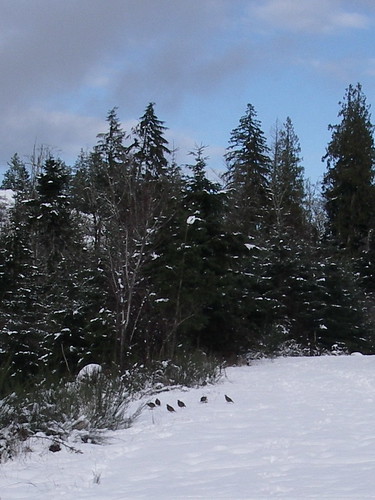
The federal government is making it illegal to damage the habitat of critically endangered killer whales off the coast of B.C. — and a coalition of environmental groups is taking credit. The government issued an order under the Species at Risk Act this week that legally protects the areas where northeast Pacific northern and southern resident populations of killer whales live. It also enhances the government's ability conduct inspections and investigations and fine parties who damage those areas, although it does not include specifics about what would constitute damage. A coalition of environmental groups says a lawsuit they launched in October, which alleges the government failed to protect killer whales' habitat as required by law, prompted the government to issue the order on Monday. Jay Ritchlin, director of marine and freshwater conservation at the David Suzuki Foundation, one of the groups involved in the case, said he is glad the federal government has now decided to take this step. "And we're looking forward to a time when they do so without having to be sued first," he said in a statement. The order is the first ever made under the 2004 Species at Risk Act. It came after the government stated in September that it would rely on existing legislation to protect the killer whales. That prompted nine environmental groups represented by Lara Tessaro, a lawyer with the environmental law group Ecojustice Canada, to file the lawsuit against the government.
Review prompted order: official
Pardeep Ahluwalia, director general of the species at risk management program at the Department of Fisheries and Oceans, said government has reviewed the killer whale protection policy it issued in the fall, taking into account comments from stakeholders, including environmental groups. "We thought we could do better and so the protection order that we published this week was in response to our review," Ahluwalia said. "It's hard to say whether or not that [lawsuit] influenced our decision." Such reviews are standard when the government is working with new legislation such as the Species at Risk Act, he said. According to the Department of Fisheries and Oceans resident killer whale recovery team, the animals are threatened by declining salmon stocks, increased boat traffic, toxic contamination, and loud underwater noises from dredging. Recent counts show 85 individuals remain in the southern population and around 245 in the northern population.
The nine groups involved in the lawsuit are:
* Dogwood Initiative.
* Environmental Defence.
* David Suzuki Foundation.
* Raincoast Conservation Society.
* Sierra Club BC.
* International Fund for Animal Welfare.
* Greenpeace.
* Georgia Strait Alliance.
* Wilderness Committee.
Tessaro said Wednesday that while she is pleased with the government's order, she won't immediately drop the lawsuit. She wants to see the final, more detailed version of the order that is to be published in the Canada Gazette on March 4 and then consult with her clients before taking that step. "I'm quite sure that this lawsuit is what forced DFO to issue this order," she said. Environmental groups are now hoping the government is serious about enforcing the new protection for killer whales and will follow up with similar orders for other endangered species, Tessaro said. "What this means for the whales is that no longer is their survival and recovery going to be dependent on old laws like the Fisheries Act or unenforceable policies," she said. "Endangered species in Canada are endangered because their habitat is being degraded. Orders protecting their habitat are fundamental if we're going to ensure that these species survive and recover."
Review prompted order: official
Pardeep Ahluwalia, director general of the species at risk management program at the Department of Fisheries and Oceans, said government has reviewed the killer whale protection policy it issued in the fall, taking into account comments from stakeholders, including environmental groups. "We thought we could do better and so the protection order that we published this week was in response to our review," Ahluwalia said. "It's hard to say whether or not that [lawsuit] influenced our decision." Such reviews are standard when the government is working with new legislation such as the Species at Risk Act, he said. According to the Department of Fisheries and Oceans resident killer whale recovery team, the animals are threatened by declining salmon stocks, increased boat traffic, toxic contamination, and loud underwater noises from dredging. Recent counts show 85 individuals remain in the southern population and around 245 in the northern population.
The nine groups involved in the lawsuit are:
* Dogwood Initiative.
* Environmental Defence.
* David Suzuki Foundation.
* Raincoast Conservation Society.
* Sierra Club BC.
* International Fund for Animal Welfare.
* Greenpeace.
* Georgia Strait Alliance.
* Wilderness Committee.
Tessaro said Wednesday that while she is pleased with the government's order, she won't immediately drop the lawsuit. She wants to see the final, more detailed version of the order that is to be published in the Canada Gazette on March 4 and then consult with her clients before taking that step. "I'm quite sure that this lawsuit is what forced DFO to issue this order," she said. Environmental groups are now hoping the government is serious about enforcing the new protection for killer whales and will follow up with similar orders for other endangered species, Tessaro said. "What this means for the whales is that no longer is their survival and recovery going to be dependent on old laws like the Fisheries Act or unenforceable policies," she said. "Endangered species in Canada are endangered because their habitat is being degraded. Orders protecting their habitat are fundamental if we're going to ensure that these species survive and recover."






































